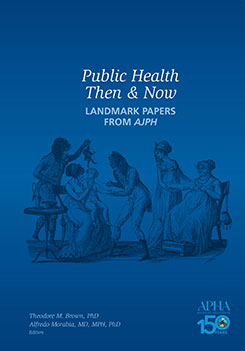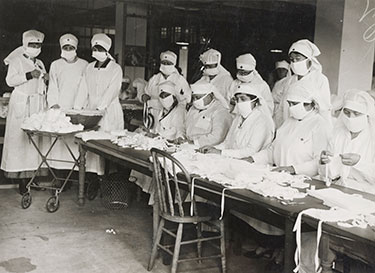A new book from APHA Press surveys the changing landscape of public health and offers lessons from its history.
“Public Health Then and Now: Landmark Papers from AJPH” collects historical essays published in APHA’s American Journal of Public Health in recent decades. The book offers perspective on the field’s major issues, achievements, ethics and stumbling blocks since the 19th century.
The 30 essays, authored by public health historians, were published in AJPH’s “Public Health Then and Now” section over the last 40 years. The book’s editors are Alfredo Morabia, MD, PhD, AJPH editor in chief, and Theodore Brown, PhD, AJPH associate editor for history.
Public health students, professionals and advocates will find a wealth of historical information in the essays that can influence approaches to current policies and programs, according to its editors.
 The arc of U.S. public health history shows that the field is complex and continually evolving, Brown told The Nation’s Health. And “despite generally good intentions, errors of omission and commission have sometimes been made” that have not always been corrected, he said.
The arc of U.S. public health history shows that the field is complex and continually evolving, Brown told The Nation’s Health. And “despite generally good intentions, errors of omission and commission have sometimes been made” that have not always been corrected, he said.
Several essays in the 600-page volume show how false assumptions were made by health agencies and departments that lasted decades. One explores the London’s well-known cholera outbreak in 1854. England’s General Board of Health held tight to the notion that the disease spread through the atmosphere, while obstetrician John Snow’s work suggested infections spread through a shared contaminated water source. While Snow was able to convince officials to remove a local pump handle, cutting off the water source and ending the neighborhood outbreak, his findings were doubted long after.
Other topics explored in the book are the tensions between the public health and medical fields which grew apart in the early 20th century. The tensions continue to play a role in the failure to establish universal health insurance in the U.S., authors say.
Successes in limiting infectious disease spread in America are also examined. Essays look at malaria in 1930s Alabama, the road to controlling tuberculosis and the 1918-1919 influenza pandemic. During that pandemic, public health measures helped contain spread by using safety protocols similar to those used during the COVID-19 pandemic, two experts write. Health officials in the early 20th century had no fallback of vaccines or other biomedical measures to stanch the spread, underscoring the effectiveness of quarantine, physical distancing and masking.
Other articles show how early detection of various cancers became more common in the 20th century thanks to preventive health examinations, and several articles explore the ethics and challenges of harm reduction programs. These include syringe replacement programs for drug users, methadone as a substitute for people who use heroin and, in the 1980s, nicotine replacement therapies to help people quit smoking.
A handful of essays tackle developments in injury prevention, occupational safety, and social and racial justice. Despite some setbacks, U.S. public health has improved in many ways, some of the writers say. Among the improvements are greater understanding of social determinants of health and the field’s embrace of science and data to guide decisionmaking.
“It is now clearly understood that social, economic and occupational circumstances and the realities of daily living can never be neglected if public health is to advance in the most powerful and equitable way,” said Brown, a professor emeritus of history in the School of Medicine and Dentistry at the University of Rochester.
“Public Health Then and Now: Landmark Papers from AJPH” is for sale online now and will be available at the APHA Press booth at APHA’s 2022 Annual Meeting and Expo in Boston. The editors will be signing the book at 1:30 p.m. Sunday, Nov. 6. On Nov. 7, Brown is part Monday’s general session, “150 Years of Public Health History.” Brown will sign books in the expo following the session.
Photo caption: Red Cross workers make masks in Boston to protect soldiers from influenza during the 1918 pandemic. Photo by International Film Service Co., courtesy U.S. National Archives.